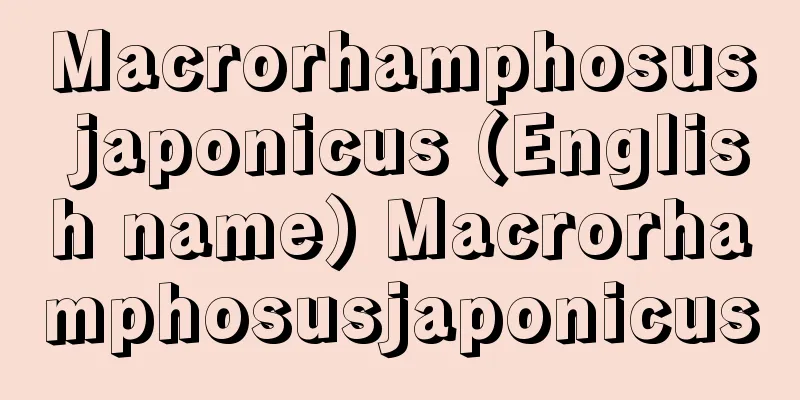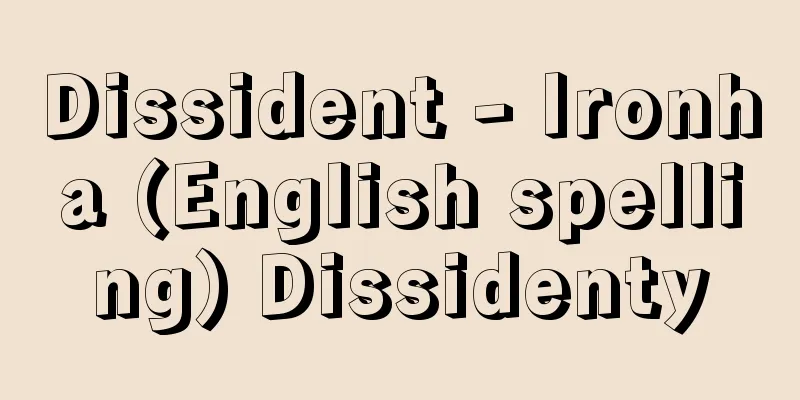Kita Ikki - Kita Ikki

|
The theoretical supreme leader of the prewar right wing. Born on April 3, 1883, as the eldest son of an old family that ran a sake brewing business on Sado Island in Niigata Prefecture. His real name was Terujiro. After dropping out of middle school in his fourth year, he read many books, and at around the age of 18, he became a local debater in the Sado Shimbun newspaper, arguing for the unification of imperialism and socialism in articles such as "Those Who Say No to War." In the autumn of 1904, he moved to Tokyo and became an auditor at Waseda University, and in 1906, he self-published a 1,000-page magnum opus, "National Polity Theory and Pure Socialism." His theory on the national polity, which denied the unbroken imperial line and said that the emperor was merely one member of the nation's highest organ, shocked the world. The book was banned, but it created an opportunity for him to join the China Tongminghui Party. In the Tongrenghui, Kita came into conflict with Sun Yat-sen (Sun Yat-sen) and allied himself with the nationalist Religious Ren (Song Chang-ren). When the Xinhai Revolution broke out in 1918, Kita went to China to participate in it, and after returning to China, he wrote "The Extra History of the Chinese Revolution" and discussed Japan's diplomacy. When the Third Revolution broke out in 1916 (Taisho 5), Kita returned to China again and worked there for over three years, but was unable to properly understand the May Fourth Movement that broke out in 1919. In the midst of his confusion, he wrote "Outline of the Principles for Reforming the State" (published in 1923 under the title "Outline of the Bill for Reforming Japan") in one go in Shanghai. This book, which discusses martial law under the supreme authority of the Emperor, the restructuring of the state apparatus, and the construction of a great Asian empire, became a bible for right-wingers for a long time thereafter. In the same year, he founded the Yusonsha with Okawa Shumei and Mitsukawa Kametaro, but it was dissolved in 1948 due to conflict between Kita and Okawa. After that, instead of creating a right-wing organization, he became a mastermind, organizing young officers through Nishida Mitsugi and gathering information on right-wing movements within the military. On the other hand, he worked behind the scenes as a "troublemaker" in cases such as the "Yasuda Kyosai Life Insurance Incident," and distributed mysterious documents such as the "Paku Ryol and Ayako Mysterious Photo Incident." He was sentenced to five months in prison for the "Imperial Household Ministry Mysterious Document Incident," which accused Makino Nobuaki and others of corruption. Since 1931, he has been paid an annual fee of 20,000 to 30,000 yen for information by the Mitsui zaibatsu. After that, he was involved in coup plots such as the October Incident and the May 15 Incident, as well as the anti-London Naval Treaty movement. During the February 26 Incident in 1936, he learned of the uprising of young officers in advance, but when he realized that they would not be able to stop it, he gave them advice and encouragement. Although this was merely aiding and abetting a rebellion, the military, which considered the "Outline of the Japan Reform Bill" to be a dangerous ideology, sentenced him to death as the ringleader of the rebellion at a special military court martial, and he was shot to death along with Nishida Tadashi on August 19, 1937. [Tatsuzo Ohno] "The Collected Works of Kita Ikki, 3 volumes (1959-72, Misuzu Shobo)" ▽ "The History of Japanese Fascism, by Tanaka Sogoro (1960, Kawade Shobo)" ▽ "Kita Ikki, by Kuno Osamu (1963, Asahi Shimbun)" ▽ "A Discussion of Kita Ikki, by Matsumoto Seicho (1978, Kodansha)" ▽ "The Showa Restoration and Right-Wing Terrorism, by Ohno Tatsuzo (1981, New Japan Publishing)" [Reference items] | | |©Shogakukan Library "> Kita Ikki Source: Shogakukan Encyclopedia Nipponica About Encyclopedia Nipponica Information | Legend |
|
戦前右翼の理論的最高指導者。明治16年4月3日、新潟県佐渡島で酒造業を営む旧家の長男として生まれた。本名輝次郎(てるじろう)。中学4年で中退後多くの書籍を読破、18歳ごろから『佐渡新聞』を舞台とする地方論客となり、「咄(ああ)、非開戦を云(い)ふ者」など、帝国主義と社会主義を合一する論陣を張った。1904年(明治37)秋上京、早稲田(わせだ)大学の聴講生となり、06年1000ページもの大著『国体論及び純正社会主義』を自費出版した。天皇の万世一系を否定し、天皇は国の最高機関の一構成員にすぎないとした国体論は、世に衝撃を与えた。この本は発禁となったが、彼を中国同盟会へ入党させる機縁をつくった。同盟会で北は孫文(そんぶん/スンウェン)と対立、国粋主義の宗教仁(そうきょうじん/ソンチャンレン)と結んだ。11年辛亥(しんがい)革命が起こると、中国に渡って革命に参加、帰国後『支那(しな)革命外史』を書き、日本の外交を論じた。16年(大正5)に第三革命が起こるとふたたび中国に渡り3年余活動したが、19年に勃発(ぼっぱつ)した五・四運動を正しく理解できず、とまどいのなか上海(シャンハイ)で『国家改造案原理大綱』(1923年に『日本改造法案大綱』と改題して刊行)を一気に書き上げた。天皇大権による戒厳令、国家機構改造、アジア大帝国の建設を論じたこの本は、その後長く右翼のバイブルになった。同19年大川周明(しゅうめい)や満川亀太郎(みつかわかめたろう)と猶存社(ゆうぞんしゃ)を創立したが、北と大川の対立で23年解散。その後は右翼団体をつくらず黒幕的存在となり、西田税(みつぎ)を通じて青年将校を組織しながら軍隊内部の右翼運動の情報集めなどを行った。一方では「安田共済生命事件」などで「事件屋」として暗躍し、「朴烈(ぼくれつ)・文子(あやこ)怪写真事件」などの怪文書をばらまいた。牧野伸顕(のぶあき)らに汚職があるとした「宮内省怪文書事件」では、懲役5か月の実刑を受けた。なお、31年(昭和6)以降三井財閥から年額2~3万円の情報料を支給されている。以後、十月事件、五・一五事件などのクーデター計画やロンドン軍縮条約反対運動などに関与。36年の二・二六事件では、青年将校らの決起を事前に知ったものの、これを押さえることができないと知るや、助言、激励を与えた。これは叛乱幇助(はんらんほうじょ)にすぎなかったが、『日本改造法案大綱』を危険思想とみなした軍部により、特設軍法会議で叛乱首魁(しゅかい)として死刑判決を受け、昭和12年8月19日、西田税とともに銃殺された。 [大野達三] 『『北一輝著作集』全3巻(1959~72・みすず書房)』▽『田中惣五郎著『日本ファシズム史』(1960・河出書房)』▽『久野収著『北一輝』(1963・朝日新聞社)』▽『松本清張著『北一輝論』(1978・講談社)』▽『大野達三著『昭和維新と右翼テロ』(1981・新日本出版社)』 [参照項目] | | |©小学館ライブラリー"> 北一輝 出典 小学館 日本大百科全書(ニッポニカ)日本大百科全書(ニッポニカ)について 情報 | 凡例 |
Recommend
Leitourgia
… [Concept and Essence] Liturgy is the general te...
Zeus faber
…[Isao Hanyu]. … *Some of the terminology that me...
TACAN
Abbreviation for tactical air navigation system. ...
Yellow cake - Yello cake
...When this solution is treated with alkali or a...
Crete [island] - Crete
A Greek island in the eastern Mediterranean, about...
Furuta Oribe
A military commander and tea master in the Azuchi...
Tonga
◎Official name: Kingdom of Tonga. ◎Area: 748 km2 ....
Londonderry (English spelling)
A city and district council area in the northwest ...
Kiyohara Natsuno
A government official in the early Heian period. ...
Five Mountains, Ten Temples, and Various Mountains
The official temple system of Zen temples (Zen Bud...
Chikuhi Line
The name of the Kyushu Railway Company's trac...
Schön, Heinrich Theodor von
Born January 20, 1772 in Schreitlaoken [Died] July...
intercumulus liquid
…This is the result of crystals that have crystal...
Shishiran - Shishiran
An evergreen fern of the family Lamiumaceae. Also...
Auspicious star - Igaboshi
〘Noun〙 (also called "ikaboshi") One of t...









